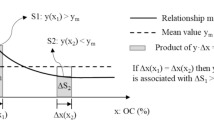Abstract
Researches to study changes in productive moisture reserves in leached low-humus medium loamy chernozem during the nongrowing period of spring wheat, depending on the preceding crop and methods of basic tillage, were performed in 2011–2021 in the forest-steppe of southwestern Siberia on a southeastern slope 1–2° steep. The fallow–wheat–oats–wheat–pea–wheat crop rotation and permanent wheat crops in the variants of zero tillage and shallow (14–16 cm) and deep (25–27 cm) subsurface plowing were analyzed. Moisture reserves in the upper 1-m-thick soil layer in autumn were determined by preceding crops (65.7%) and their interaction with cultivation methods (30.9%). They decreased from fallow (109.2 mm) to pea (88.1 mm), oats (82.4 mm), and permanent wheat (72.6 mm) as well as from deep (91.4 mm) to shallow (88.7 mm) and zero (84.0 mm) cultivation. In early spring, moisture reserves were mainly determined by the cultivation method (81%), decreasing from deep (169.4 mm) to shallow (145.8 mm) and zero (118.4 mm) plowing and from fallow (156.6 mm) to pea (144.4 mm), oats (140.0 mm), and permanent wheat (136.9 mm). The accumulation of winter precipitation by soil was determined by the cultivation method (81.0%), decreasing from deep (77.9 mm) to shallow (57.0 mm) and zero (34.4 mm) treatment and increasing from fallow (47.5 mm) to pea (56.3 mm), oats (57.7 mm), and permanent wheat (64.3 mm). By the germination period, moisture reserves in the soil decreased, depending on the cultivation approach (87.6%), from deep (120.1 mm) to shallow (108.5 mm) and zero (100.5 mm) plowing. Moisture losses in spring on an unplowed background were minimal (81.2–87.5 mm) and increased on backgrounds with shallow and deep plowing (92.8–117.8 and 101.0–135.2 mm, respectively) and from permanent wheat to oats, pea, and fallow.
Similar content being viewed by others
REFERENCES
Ivanov, A.L., Kulintsev, V.V., Dridiger, V.K., et al., Feasibility of a direct sowing system on the Russian chernozems, Dostizh. Nauki Tekh. APK, 2021, vol. 35, no. 4, pp. 8–16. https://doi.org/10.24411/0235-2451-2021-10401
Kiryushin, V.I., State and problems of development of adaptive-landscape agriculture, Zemledelie, 2021, no. 2, pp. 3–7. https://doi.org/10.24411/0044-3913-2021-10201
Gusev, Ye.M., Dzhogan, L.Ya., and Nasonova, O.N., Scenario projections of the changes in water availability to wheat crops in the steppe Crimea in the 21st century and some measures increasing the efficiency of its cultivation, Eurasian Soil Sci., 2021, vol. 54, no. 5, pp. 763–771. https://doi.org/10.1134/S1064229321050100
Kuzychenko, Yu.A., Tillage systems in the crop rotation in the Central Caucasia, Vestn. Kazan. Gos. Agrar. Univ., 2020, vol. 15, no. 2, pp. 25–28.
Yushkevich, L.V and Golovanov, D.A., Water permeability of chernozem soils of the South forest-steppe of Western Siberia, Zemledelie, 2017, no. 5, pp. 30–32.
Kiryushin, V.I., The management of soil fertility and productivity of agrocenoses in adaptive-landscape farming systems, Eurasian Soil Sci., 2019, vol. 52, pp. 1137–1145.
Glazunov, G.P., Afonchenko, N.V., and Dvoinykh, V.V., Influence of morphometric terrain indicators on the fertility of chernozem soils, Dostizh. Nauki Tekh. APK, 2020, vol. 34, no. 7, pp. 10–18. https://doi.org/10.24411/0235-2451-2020-10702
Khakimov, R.A., Nikiforova, S.A., and Khakimova, N.V., Formation of winter wheat yield after seeded fallow, depending on the level of mineral nutrition, Dostizh. Nauki Tekh. APK, 2021, vol. 35, no. 2, pp. 33–40. https://doi.org/10.24411/0235-2451-2021-10205
Shakirov, R.S., Bikmukhametov, Z.M., and Khisamiev, F.F., Adaptive resource and moisture-saving ways of increasing the wheat productivity and reproduction the fertility of grain forest soil of the Kama region of Tatarstan, Vestn. Kazan. Gos. Agrar. Univ., 2018, vol. 13, no. 1, pp. 83–90.
Usenko, V.I. and Usenko, S.V., Water regime of leached chernozem depending on forecrops and tillage methods, Zemledelie, 2018, no. 2, pp. 14–18.
Usenko, V.I. and Usenko, S.V., Efficiency of mineral fertilizers for spring wheat in dependence of the forecrop, soil cultivation and plant protection means in the forest-steppe of the Altai Ob region, Zemledelie, 2016, no. 8, pp. 4–8.
Author information
Authors and Affiliations
Corresponding author
Ethics declarations
The authors declare that they have no conflicts of interest. This article does not contain any studies involving animals or human participants performed by any of the authors.
Additional information
Translated by I. Bel’chenko
About this article
Cite this article
Usenko, V.I., Garkusha, A.A., Litvintseva, T.A. et al. Changes in Moisture Reserves in Leached Chernozem during the Nongrowing Period, Depending on the Preceding Crop and Basic Cultivation. Russ. Agricult. Sci. 47 (Suppl 1), S9–S14 (2021). https://doi.org/10.3103/S1068367422010141
Received:
Revised:
Accepted:
Published:
Issue Date:
DOI: https://doi.org/10.3103/S1068367422010141




